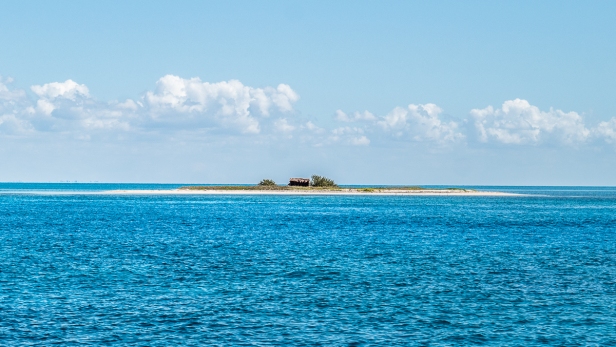
24 February 2017. The breeze caresses our skin as the sun warms it. Don sits facing the sea. I sit behind him with my arms around his waist and my head resting on his shoulder. The warmth of our bodies transfers from me to him and him to me. The salsa music speaks to the dancing beat of our hearts, and the tranquility of the endless blue sea and sky seeps right into our bones. We are on a yacht heading from the town of Trinidad on the main island of Cuba to Cayo Las Iguanas, or Iguana Island, for a day on the water and at the beach.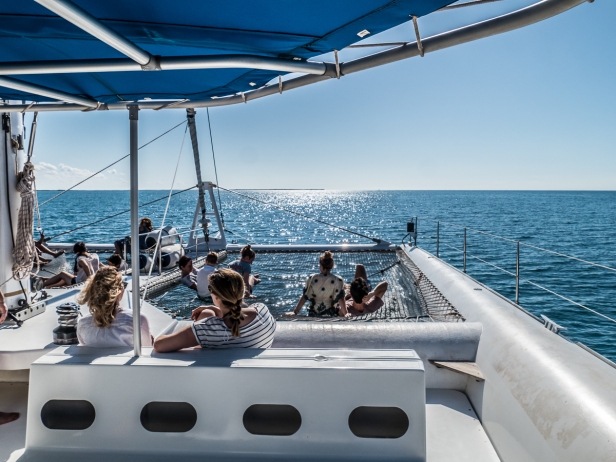
It’s like a mini break. It’s tropical paradise territory. It’s Cuba for tourists. We have a choice to take a day tour to Cienfuegos, yet another Cuban city with a beautifully preserved colonial core, or to get out in nature for the day and take a day off from Cuba’s confusing contradictory urban landscape. We look at pictures and Cienfuegos looks beautiful, but still it’s a city, and we need the nourishment of nature. We choose to escape for the day.
As we cruise towards Iguana Island we pass local fishermen in their small wooden boats with makeshift sails,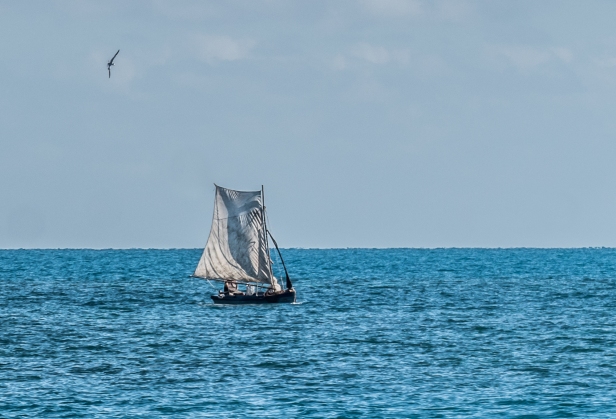
a flock of cormorants sunning themselves on a row of abandoned wooden poles grey with years of weathering, and idyllic small white-sand islands with palm trees waving in the breeze. I half expect Robinson Crusoe come out from the palapa and wave to us. It’s that kind of setting.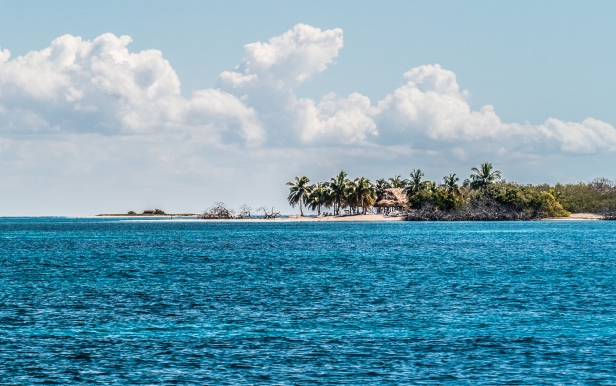
Although the island, twenty miles from Trinidad, is called Iguana Island, and the advertising for the cruise showed pictures of iguanas, I was skeptical that we would actually see any. I thought perhaps we’d see one or two if we were lucky.
Arriving at the island we amble along the dock to the enticing beach and palm trees. It all looks so perfectly blissful.
And then we see them! They are everywhere on the sand and in the nearby bushes, running around, or sparring with each other, or sunning themselves. Dozens of them with their thick tails, red eyes, and spikey spines.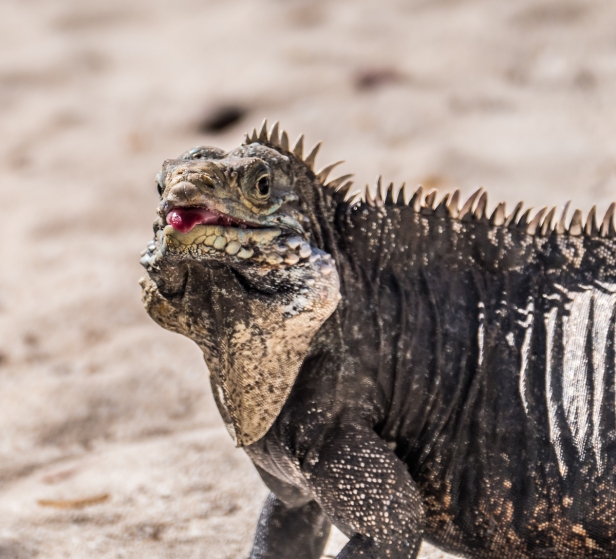
Big ones, small ones, tiny ones. The bigger ones are four feet long with thick round bodies.
There are so many we have to be careful where we walk.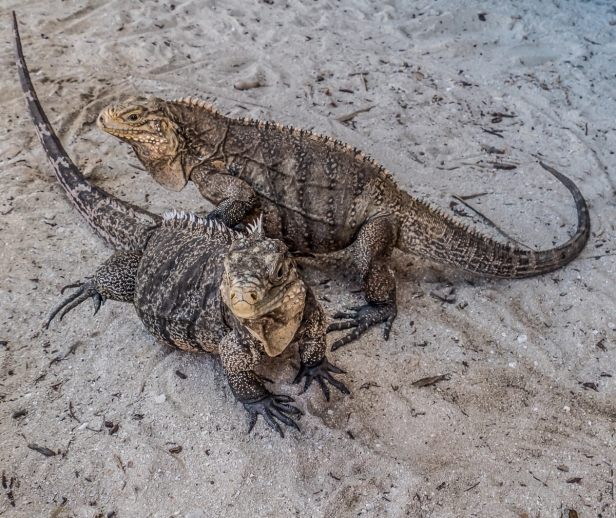


Cuban Rock Iguanas are endemic to Cuba, and are one of the biggest lizards in the Caribbean. They are an endangered species, but clearly they are not endangered here on Iguana Island.
We are dumfounded. Along with the iguanas there are dozens of hutias, a large rodent that is also endemic to Cuba. We’ve basically landed on a beach populated with dozens of giant rats and prehistoric lizards.

The hutias are milling around along with the iguanas as if they are waiting for us. It’s an unexpected welcoming party of unusual size.
We dump our bags and towels and wander amongst this surprising crowd of creatures who couldn’t be more different from each other. Neither the hutias nor the iguanas seem aggressive, or even that much interested in us at all. “Ho hum another boatload of tourists – but we know what’s coming later. Lunch!”
Close to where we land there’s a large open-sided palapa filled with long tables and benches where lunch will be served, and a bit beyond that another building where lunch will be prepared. As far as I can tell that’s all there is on the island.
The sea is a perfect turquoise, the sky is a perfect azure, the sand is soft underfoot. We sink down in this tropical paradise entertained by our serene surroundings and the very active wildlife.
Soon lunch is served in the palapa. The food is good enough, as is the way in Cuba – great heaping platefuls of flavoured rice, lobster, salad, and bread. After lunch the local wildlife explodes into a frenzy of action as all the leftovers are thrown onto the ground behind the palapa. Lunch for the tourists means lunch for them too. Dozens and dozens of the iguanas rush to the five or six piles of leftover food that have been thrown down. Some hutias get in on the action but it’s mainly the iguanas.
Still, the hutias have their ways of getting to the food. This piece of bread that the hutia is holding was seconds earlier in the open mouth of the iguana.
The hutias, which can be as big as 8.5 kg (19lb) (think extremely large domestic cat), are hunted for food in Cuba. The meat is tasty, and even more so when cooked in the usual way with wild nuts and honey.
I go for a walk after lunch and find perfect little hidden coves,

a great blue heron fishing in the shallows, a shy green heron almost hidden amongst the tree branches,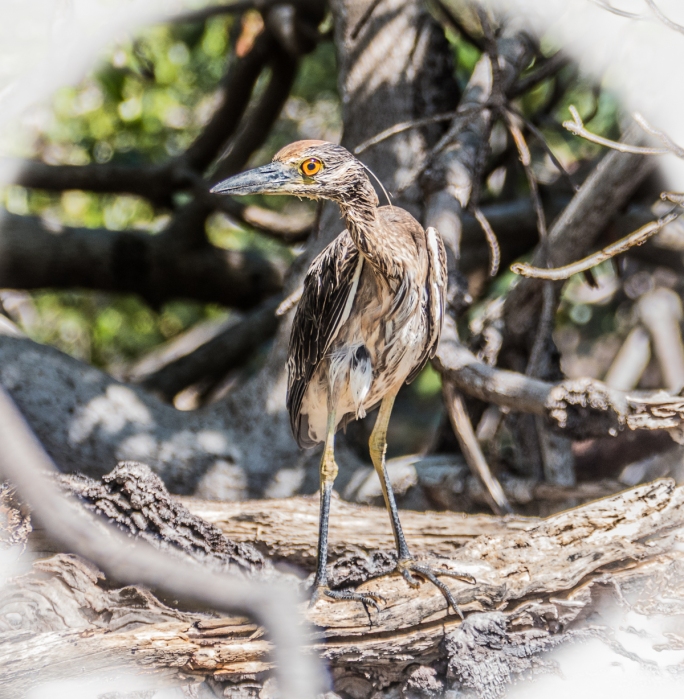
a great egret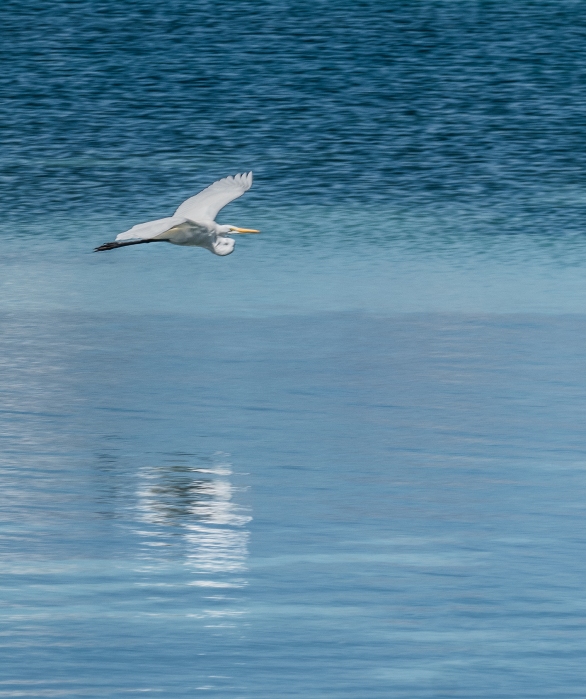
and a couple of yellow warblers, one in the bushes and one on the lunch table.

I collapse next to Don on the beach, letting myself be lulled by our surroundings. All is tranquil except for two large alpha-male iguanas sparring with each other,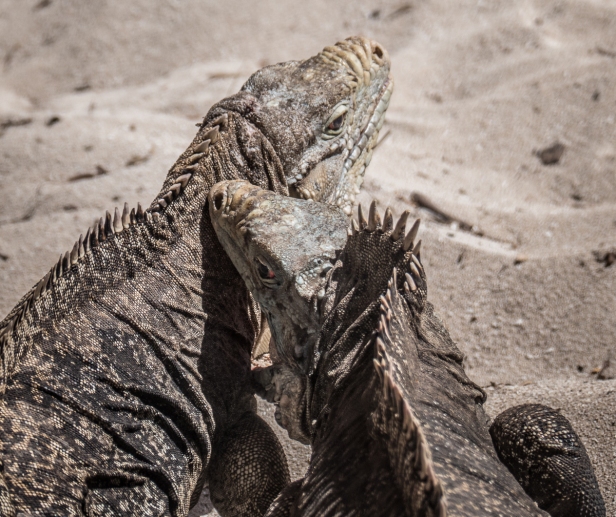
while this young boy, fascinated with the wildlife, reaches out to pet one of them.
Clearly he is not afraid, and neither are we, and we never have any reason to be, though I did read a post on Double-Barrelled Travel about the hutias and iguanas crowding up to people at the lunch table, and that one large iguana actually launched itself right onto the table! Eeek! Apparently most people that day didn’t hang around to finish lunch. Two years later the tour operators have clearly figured out a way to keep the wildlife away from the palapa until it’s time to feed them the leftovers, though we have no idea how they’ve managed to do this.
At the end of the day, lazing on the boat during the two-hour journey back to Trinidad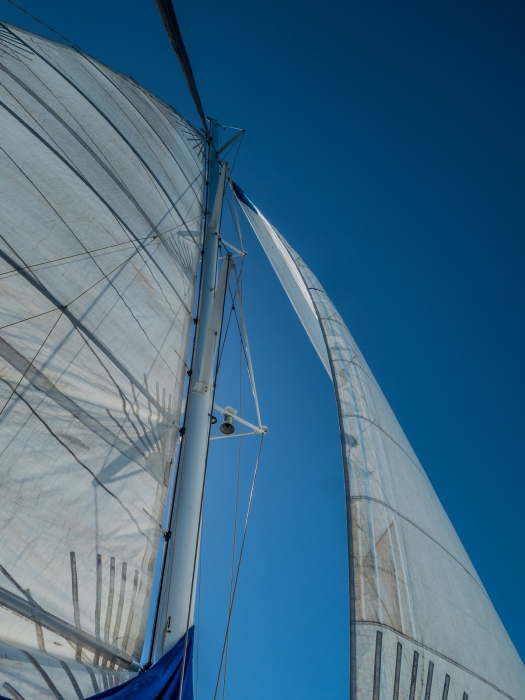
we feel sun-soaked and sated. It’s been a surprising day, as well as a sweet easy time of relaxation and rest.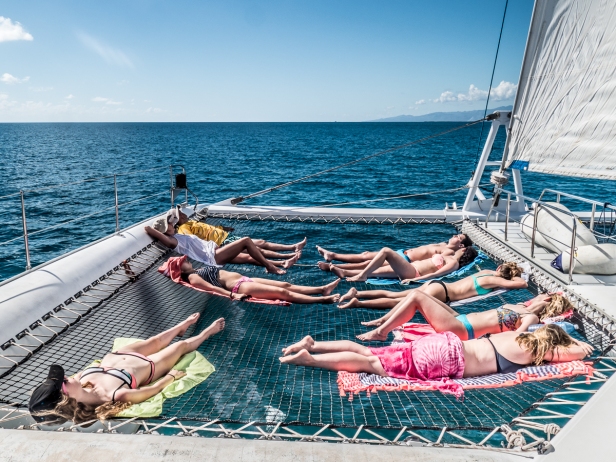
Next post: A story of pain and healing
All words and images by Alison Louise Armstrong unless otherwise noted
© Alison Louise Armstrong and Adventures in Wonderland – a pilgrimage of the heart, 2010-2017.

We saw a lot of those Hutias on Devils Island. They were everywhere. Gorgeous photos!
LikeLike
Cindy, I found you in spam! That is wrong on so many levels! 🙂
Thanks re the pics. I was so excited about all the wild life, seeing so many and them being so unafraid of us. Different variations of the hutias must be found throughout the Caribbean. I think I read that in Cuba alone there are 3 species.
Alison
LikeLike
Your bird photos are fantastic, Alison.
Peggy lived in Panama with her first husband and two babies years before we met. Iguanas were quite common and, as you have noted, not aggressive. The problem was that they fell out of trees, and they were big. The two year old Tasha was playing outside in the yard when one of the big fellows came crashing down, missing Tasha by inches! After that, Mom was more cautious about where Tasha played. –Curt
LikeLike
Thanks Curt. I can’t imagine if one of these fell out of a tree next to me, let alone a 2 yr old. I bet Tasha was a tad surprised. I did have a python fall out of a tree next to me in Oz – but it was a few feet away and it was busy eating a bat.
Alison
LikeLike
My first wife had a mamba fall out of a tree next to her in Africa, Alison. The bad news for the mamba was that Jo Ann had a machete and the Mamba quickly became chopped up mamba! 🙂 –Curt
LikeLiked by 1 person
Wow! I bet that was exciting! 🙂
Good thing she had a machete – I get it – it was her or the snake.
A.
LikeLike
The snake didn’t stand a chance. 🙂 –Curt
LikeLiked by 1 person
Wonderful post and great pictures! The first time I saw an iguana was in Sitee River, Belize (we’re not familiar with them in the western part of Europe). As is was mating season the skin of the males turned into a vibrant orange, and they were sooo large! Really like these prehistoric animals! Marcella
LikeLike
Thanks so much Marcella. Oh I’d love to see them turn bright orange! Some of the ones on Iguana Island were pretty large. You can tell a bit from the one the little boy is petting – that was one of the smaller ones.
Alison
LikeLiked by 1 person
and i love the blues…i’ve never seen so many iguanas in one space like this…it’s a warm post…we are in the winter mode…i’ve got to make a plan for that blue soon…have a delightful weekend Alison…sending joy 😀
LikeLiked by 1 person
I too love the blues, and the warmth. And right now I’m glad of our cosy gas fire. We’re definitely in winter mode here too. Hope you get to the blue soon. Hope your week is lovely! Sending smiles.
Alison
LikeLiked by 1 person
It’s a bright snowy day ❄️☀️😎 have a happy week Alison
LikeLiked by 1 person
Alison, this is such a wonderful post filled with beautiful photos of the beach and comical shots of the hutias and iguanas! I chuckled at the one where an iguana looks helpless as a hutia eats the very piece of bread which seconds earlier was in the iguana’s mouth. Iguana Island does look peaceful and idyllic — what a treat for the senses!
LikeLiked by 1 person
Thanks so much Bama. It was such a beautiful idyllic place, and all the wildlife was so interesting and entertaining. Not quite as big as Komodo dragons! I hope to see them one day.
Alison
LikeLike
Great shots of the wildlife and the water.
LikeLiked by 1 person
Thanks Peggy. The setting was classic, and the wildlife anything but!
Alison
LikeLike
That is extraordinary! What a fascinating combination of creatures. I would love such a place. I think having seen your beautiful photos filled with sunshine I’ve warmed up from our snow globe current weather.
LikeLiked by 1 person
Thanks Sue. You have snow globe, we have frosty. Brrr. Glad Iguana Island warmed you up a bit. It turned out to be way more interesting than I expected. It was a good day.
Alison
LikeLiked by 1 person
Alison,
If I were a caricature artist, I swear the frontal look of an Iguana would instantly remind me of Donald Trump readying himself to say something…. The classic stare of a mean spirited living thing with a bony head.
I wonder if the Iguanas can tweet?
LikeLiked by 1 person
Well this made me chuckle Mashoud. Perhaps he’s an iguana in disguise 🙂
Alison
LikeLike
Alison and Don, love this post. It is so fun to read about other bloggers experiences from places we have been and in particular to be continually reminded that there are so many ways of enjoying any destination.
We got ourselves to Cienfuegos for a day and got our nature fix at the bird nature reserve near the Bay of Pigs. Cienfuegos was worthwhile, although we did not know about this iguana island which certainly sounds fascinating and unique. Your photos of the iguanas are amazing and as well those of the rodents.
When we worked in bamboo in Nicaragua, and built a factory in the middle of Mayagna Indian towns, they too were big consumers of this rodent. Ben of course seized the opportunity to try something new, but you couldn’t pay me to try that! Haha…
Love the hammock type netting for relaxing on during the boat ride. Looks dreamy!
Peta (& Ben)
LikeLiked by 1 person
Thanks so much Peta. We only had 2 weeks in Cuba, so had to pick and choose where to go. We also did a train trip to an abandoned sugar mill, and a hike through a national park – coming up in a future post. So in the end Cienfuegos had to be sacrificed. I think I would have tried the hutia dish had I been offered it, especially if I didn’t know what it was! I used to cook in big game hunting camps in northern Canada so have eaten moose, cariboo, bear etc. Still there was no way I was going to eat cuy in Peru so I guess we each have our limits.
Alison
LikeLike
Brilliant set of photos of an amazing and fascinating place. I would never have known a place like this existed. Bless you both, Alison and Don, for sharing your fabulous adventures.
LikeLiked by 1 person
Thank you so much. Certainly we would not have known such a place existed had we not seen the tourist brochures in Trinidad. We’re so glad we went. It was such a lovely day, and a great pleasure to share about it here.
Alison xo
LikeLiked by 1 person
This reminds me very much of my trip to Belize in 2016. Iguanas everywhere there too, though a different species than your Cuban ones. Lots of warblers too, but no giant rats! I’m so glad you choose nature over another city – it sounds like the right break for you, and being on the water always makes me happy, so I got to be happy vicariously via your boat pictures!
LikeLiked by 1 person
I guess there are iguanas throughout Mexico and the Caribbean. Not sure about Central America though I’d guess they’re there too. We’d seen one of the giant rats in a cage on the sidewalk in Havana. I’d guessed at the time it would be dinner. I thought the giant rats on Iguana Island were quite cute, though I didn’t know at the time that they were actually rats. It was exactly the right break for us. I’m glad you enjoyed it vicariously!
Alison
LikeLike
Rodents of unusual size, eh? Was there a fire swamp?
Lovely pics. Looks like a beautiful way to spend a day.
LikeLiked by 1 person
Thanks Dave. Lol, no fire swamp 🙂
And yes, it was a beautiful way to spend the day. We’re glad we made this choice even if it did mean we missed out on Cienfuegos.
Alison
LikeLiked by 1 person
Reblogged this on World4Justice : NOW! Lobby Forum..
LikeLiked by 1 person
Thanks for the reblog. Much appreciated.
Alison
LikeLike
Cool interlude!
LikeLike
Yes, it was a very cool interlude. The time on the boat was so relaxing, and on the island all the wildlife was so entertaining. A good day.
Alison
LikeLike
I am so glad that Iguana Island was filled with iguanas….and hutias…and such colourful birds. I would have been skeptical about many iguanas actually being visible on an island named for them. Stunning photos!
LikeLiked by 1 person
Thanks so much Donna. We went on a day tour in Turkey up the Dalyan River. The advertising talked about a stop at Turtle Beach, and there was an image of a large turtle. So we get to Turtle Beach and we’re then told we won’t see any because they only come to the beach at night! I guess it was this experience that made me sceptical about seeing any iguanas, and also that usually iguanas are fairly well hidden. So it was such a surprise to see so many, but of course lunch makes them hang around. It was really exciting to see so many, and all the hutias, and the birds. I’m so happy in being in nature and seeing wildlife in its natural setting.
Alison
LikeLike
The color of that ocean is exquisite — like unpolished apatite, a favorite gemstone. And I love the harmony among these two creatures that seem so completely different. Thanks for this warm ocean getaway on a very cold weekend in Vancouver!
LikeLiked by 1 person
You’re welcome. It’s helping warm me up a little too just remembering 🙂
This is such an unusual fall here! Usually it’s nothing but rain rain rain. I do hope it doesn’t mean another winter of lots of snow! I’d rather have the rain any day than the continuous snow I heard you got last winter.
There’s nothing quite like the colour of tropical seas and sky – such an intense blue it almost makes your eyes water. And all the wildlife just made my heart sing!
Alison
LikeLike
I was loving the incredible blue of the sea and was feeling gently lulled into languor when giant lizards suddenly popped out of your post! Haha – I actually find iguanas fascinating and not too scary. More surprising than anything as they come around a corner and you are face to face with a prehistoric-looking creature. I can’t even imagine a parade of them like you saw! Your bird photos are so stunning, and even though I don’t love the idea of large rats, even the hutias look kind of cute through your lens!
LikeLiked by 1 person
Thanks Lex. I did think the hutias were cute. I didn’t know they were actually rats, but it doesn’t matter really. They reminded me of quokkas, a small marsupial found only on Rottnest Island off the coast of Perth.
You can see how similar they are, and about the same size. I guess I just thought of the hutias as mammals and didn’t go beyond that.
There’s nothing like the blue of tropical seas to lull you into complete relaxation is there? Even with an abundance of lizards and rats around! And the birds were a complete bonus.
Alison
LikeLiked by 1 person
They reminded me of the hyraxes we saw in Tanzania, which I also thought were cute rodent-like mammals, but we learned they are related to elephants and manatees! Same body shape and hair as your hutias and quokkas.
LikeLiked by 1 person
I remember learning about the hyraxes – that they’re related to elephants. I was completely gobsmacked. Understanding that connection requires a far more arcane understanding of biology than I have.
LikeLiked by 1 person
The hutias are so like the quokkas we saw in Rottnest Island…I wonder if they are related? Can’t believe the size of those lizards, I guess with no predators and plenty of food they just get larger and larger? As always beautiful photos.
LikeLiked by 1 person
Thanks so much Gilda. I had the same thought about the hutias, and of course Rottnest Island got its name because the original Dutch explorers thought the quokkas were rats. See my reply to lexklein immediately above. I doubt they are related since quokkas are marsupials which only exist in Australia. I did read that the Cuban Rock Iguana is one of the biggest species of iguana in the Caribbean. The biggest were pretty big, their bodies about 2 feet long. Wouldn’t want to mess with one!
Alison
LikeLike
The rhythm of your post creates a mood of a slow, sun soaked day and your photos, as usual, take me right to Iguana Island. It does looks like a movie setting for a castaway picture but it would take me a lot of work to think about living on iguana and hutia! I remember seeing people alongside some of the back roads in Nicaragua selling live iguanas to cook but, no, we weren’t even tempted! However, I would like to pet one like the boy in your picture and love the fact that these reptiles and hutias have no fear of humans. Kind of like a mini taste of the Galapagos Islands! Anita
LikeLiked by 1 person
It was a wonderful slow sun soaked day, and we really needed it, and yes, it was like a mini taste of Galapagos – animals without fear of humans – which I loved about both places. You could get to really watch them just doing their thing without them running away. Still, even though I was never tempted by the cuys in Peru I do think if I was a castaway I’d probably come around to eating iguanas and hutias 🙂
Alison
LikeLike
Wow! What a fantastic collection of images – those Iguanas!! I’ve never heard of Hutias – giant rodents before. Crazy! I also love the last shot of the yellow warbler on the edge of the plank! I am following you, but I’ve been receiving notifications – so I’ll nee to check in to your site regularly. I appreciate your checking out my simple photo-a-day postings.
LikeLiked by 1 person
Thanks so much Mike. We’d never heard of hutias before either. It was only after we got to Cuba that we discovered them. Iguanas of course we’d seen several times in Mexico, but never in the numbers on Iguana Island.
I take it you mean you’re not receiving notifications. Perhaps if you go into the WP reader you can fix it.
https://wordpress.com/#!/read/following
On the left is a sign “Followed Sites”. Click on Manage. Our site will be there as part of the list of blogs you follow. Click on settings for our site and you can choose how often you want email notification of new posts. Hope this helps.
Alison
LikeLiked by 1 person
Yes, I’ve done that before – so should be good now. How long will you be in Vancouver?
LikeLiked by 1 person
hey yall are so talented
LikeLiked by 1 person
Thank you so much!
Alison
LikeLike
As the kids say, OMG! 😀 Your post is marvelous as you bring us into this unusual world of iguanas and rodents…too much. Your images are simply fantastic in showing us the wildlife and landscape. Great post Alison and Don.
LikeLiked by 1 person
Thanks so much Jane. It was definitely an OMG kind of place! I’m glad I managed to capture something of the feel of it. The combination of the boat trip, and the whole tropical paradise thing, and then all the animals made for a great day.
Alison
LikeLiked by 1 person
Wow. What an amazing place. Love that picture of the hutia stealing the bread. The look on the iguanas face is a classic mix of bewilderment and disgruntlement!
LikeLiked by 1 person
Yes, it is an amazing place. We were just thrilled with it – with the idyllic tropical setting and all the wildlife it made for a fabulous day. You made me go back and look at the iguana who had his bread stolen – you got it right – bewilderment and disgruntlement. “What just happened?”
Alison
LikeLiked by 1 person
What an amazing place i’d like to go there soon ! ❤
LikeLiked by 1 person
Oh I do hope you get to go there, it really is amazing and we’re so glad we went.
Alison
LikeLiked by 1 person
Cayo Las Iguanas seems so magnificent and awe-inspiring, Alison and Don!Your pictures have left me speechless. Is a day trip enough to explore this paradise properly?
LikeLiked by 1 person
Thanks so much Agness. Iguana Island really is a fabulous place. I don’t think you’d need more than a day, but either way I’m not sure you’d be allowed to stay overnight on the island. I’m pretty sure there’s no accommodation on the island. Maybe they’d let you bring your own tents. Don’t know about the water situation.
Alison
LikeLike
Cuba is an awesome place for a holiday! I was there already three times and I think I will choose it next summer too 🙂 Very nice photos, awesome lizards!
LikeLike
Thanks so much Wojtek. We found Cuba pretty fascinating, and the day on Iguana Island with the iguanas and hutias was definitely awesome.
Alison
LikeLike
Your photos make me want to put down the computer and rush to the airport and hop a flight! We would have opted for rats and lizards too instead of another big city. I had never heard of this island. Certainly something to consider when taking a trip to Cuba.
LikeLiked by 1 person
Thanks LuAnn – hope you got that flight! It was a lovely day. We always enjoy a day on the water, especially in the tropics – what’s not to love?! But the added bonus of all the wildlife made it all the more special. Would definitely consider it if in Cuba. The trips run from Trinidad which is worth visiting for sure.
Alison
LikeLiked by 1 person
I just hope we get to see half the places that you and Don have seen before our traveling days come to an end.
LikeLiked by 1 person
such a romantically tropical
holiday adventure
complete
with lovely creations 🙂
LikeLiked by 1 person
Such lovely creations
iguanas doing their iguana thing
hutias doing their hutia thing
and we got to watch the show.
Lucky!
And the tropical paradise setting
created magic!
Alison
LikeLike
thank you for the peek!
stretches the mind, the variety
in this world!
LikeLiked by 1 person
My pleasure! I think it’s the reason I love to travel – all that mind stretching is good for the soul 🙂
Alison
LikeLiked by 1 person
Sounds like a perfect day. It’s always so relaxing out on the water. It was good of the critters to wait for their snack after you were finished eating!
LikeLiked by 1 person
It was a perfect day! The setting, being on the water, the tropical warmth, and all those well-mannered critters to entertain us. Sweet.
Alison
LikeLike
Alison, I think you made the right choice that day to select nature. I can’t get over these two very different creatures hanging out together on Iguana Island. Your wildlife photos are all extraordinary, and the photo of the iguana next to the hutia just cracks me up (something you might expect in a computer-animated film).The birds are exquisite. What a nice day! Cheers, Caroline
LikeLiked by 1 person
Thanks so much Caroline. We were completely amazed by the wildlife – both the numbers and the juxtaposition of two such different creatures. They seemed to live together in complete harmony, even if the hutias were thieving food right from the mouths of the iguanas! I’m so glad we went. We were really in need of a day away from the city and it turned out to be better than expected.
Alison
LikeLike
A fantastic set of photographs Alison. The Huita reminds me of the Quokka which can be found on Rottnest Island, near Perth WA.
I’ve only ever been on one island where the wildlife was total unafraid of man and that’s Sealion Island in the Falklands. There you could see all sorts of wildlife, Wild eagles who would sit and wait for you to feed them. No Iguanas, instead Bull elephant seals and their harems of cows. We were warned not to get between them and the harem, or between them and the sea. Despite their size and bulk they can move incredibly fast on land.
LikeLiked by 1 person
Thanks so much Mike. The hutias reminded me also of quokkas. We visited Rottnest a few years back. Sealion Island sounds amazing – I’d love to see the eagles! It reminds me of Galapagos – another place where the wildlife is unafraid.
Alison
LikeLike
Fabulous
LikeLiked by 1 person
Thank you. And thanks for all the likes and for following! I hope you continue to enjoy the blog.
Alison
LikeLike
Welcome for your sweet words
LikeLiked by 1 person
Alison, I love the photo of the iguanas circled around the food. And the yellow warbler photo is excellent. I’m a birdwatcher, and frustrated bird photographer who takes crappy shots of birds 99% of the time. So, I appreciate how hard it is to get good bird photos, and there are really good ones in this post. ~James
LikeLiked by 1 person
Thanks so much James. Oh don’t doubt I’m a frustrated bird photographer too. I certainly get the crappy shots 99% of the time. C’est la vie. It makes it even sweeter when I get a good one.
Alison
LikeLike
Awesome photos! Thanks for sharing.
LikeLiked by 1 person
Thanks so much John.
Alison
LikeLike
Pictures are Stunning! Just inspired me to plan for next trip.. Thanks for Great Information.
LikeLiked by 1 person
Thanks so much. It’s really worth visiting.
Alison
LikeLike
hutias are not rats, or even closely related. they are in the same grouping as guinea pigs and capybaras. most species have become extinct due to human over-hunting and habitat destruction but the Cuban species shown here is doing the best of any and has some protected areas; there are none in Central America so what was written about there was a different animal. i’ve gotten to see them several times and it is always a treat. i find them both attractive and interesting – and yes, superficially, they are a bit like both quokkas and hyraxes. thanks for the photos !
LikeLiked by 1 person
Oh I was using the term loosely since they’re all rodents. I have no idea about hutias in Central America. I loved being on that island with so much wildlife that was unafraid of us. Thanks for commenting.
Alison
LikeLike